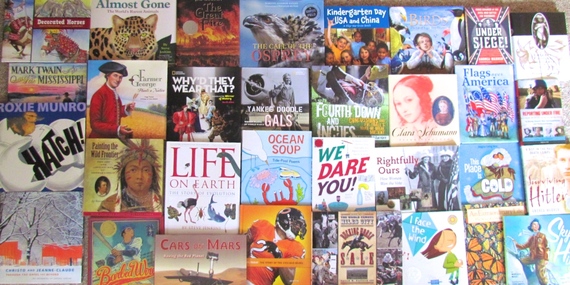A retired public elementary school principal recently told me that the rule in education used to be that grades 1-3 were about learning to read. After that, it was reading to learn. But that's not happening today with the current emphasis on ELA skills through the Common Core State Standards. The emphasis is on skills. There is nothing about content. Content matters. You can't teach critical thinking without thinking about something. Nonfiction literature gives readers something to think about. Let me show you a picture worth thousands of words:
If you, an educated adult, read this sampling of children's nonfiction literature, you'd learn a great deal. Each book is extensively researched and vetted for accuracy and beautifully designed and illustrated. If it is a narrative, the story is told in a compelling, page-turning manner. If it is a how-to book, directions are clear and motivation is embedded in the exposition. History, geography, sports, science, nature, art and music are all represented in this small library. Yet, for the most part, these engaging books never make it to the classroom. Instead, children read flat, dry, "informational" material that comes with work sheets and lesson plans. Teachers do not know that these books exist, that they cover the same topics that are in their curriculum, and even if they do know about them, they are not sure of how to use them in the classroom.
You know who does know about these books? The standardized testing companies. They excerpt passages (paying licensing fees) for the test questions. So if this writing is good enough for the tests, don't you think kids should read them in the classroom?
Without experience in reading high-quality nonfiction, children are not building a foundation of knowledge, not learning to think in a disciplinary way, and are not preparing to be informed decision makers. The main difference between these books and those written on these subject for adults, is that children's authors assume that their readers have little to no prior knowledge. Concepts are carefully introduced and reinforced so that the content is not overwhelming to the reader. Authors honor their readers and assume they are writing for intelligent human beings who may be uninitiated in the subject matter. The authors' voices, their humor, wit, passions, inform the books. As an author of science books for children, I have often said that if one of my books is the first book on a subject a child reads, I have failed if it is the last.
Interestingly, most independent, private schools that have a long tradition of teaching "literature-based" content through trade books. Yet, the obstacles for public school use appear to be overwhelming:
- There is little or no correlation between trade books and the curriculum. The mindset is to use the textbook and the prescribed lesson plans. Teachers are afraid to stray from the top-down mandate for the use of textbooks and approved materials. They are required to "cover" the material often in ways that discourage real learning. Fear of not meeting standards is assuaged through the use of scripted lessons, while authentic learning suffers. Educators may know this but conform to keep their jobs. Teaching well takes more time than is allowed by pacing calendars.
- Teachers have little or no familiarity with children's trade nonfiction and have almost no time in their busy schedules to start reading them. They also often don't have the autonomy or the skills needed to create their own lesson plans based on real books. A licensed school librarian can help.
- There is little or no funding for classrooms sets of these books so that the learning and reading can be both an individual and shared experience by the students. Some school districts have purchased classroom sets that can be borrowed by teachers when they're needed. But they are the exceptions.
The Common Core State Standards mandate that kids read widely and read closely. The vast array of high quality children's nonfiction literature is waiting on the shelves of libraries everywhere to do just that. Research on the web is great if you know what you don't know. These books open doors to topics they didn't know they didn't know. It can be the basis for an upgrade in education and learning everywhere.

